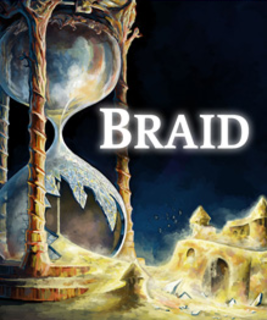Braid: is excellent and gorgeous, a little over-hyped, but maddeningly fun overall.
At first glance, Braid might appear to be a run-of-the-mill (though still visually fetching) 2D platformer. This is not the case. Although Braid has very simple controls, the gameplay mechanics and concepts present in the journey are surprisingly complex and will require a fair bit of patience and cleverness. By using Tim's ability to rewind time with the push of the Square button, elaborate scenarios will challenge your perception of normal 2D puzzles and force you to think in new ways.
Each world, which is connected to a central hub, is divided into several sections. In most sections, players must guide Tim through the level and collect puzzle pieces along the way, which are then used to assemble beautiful paintings that hang in Tim's home. Early on in the game, time manipulation is used in very simple ways, like saving Tim from an untimely end if he hits one of Braid's wandering enemy creatures. In this way, there really is no "Game Over" or end to Braid, as every mistake can always be rewound if you hold down the Square button long enough. If players feel lost, they are welcome to start that portion of the world over at their leisure.
As players progress through the worlds, different types of time/environmental manipulation will become available to Tim, though some of them are only used in that world. For example, there is one instance where time will only move foward as Tim progresses physically in the stage. Walking backwards will rewind time. In another world, Tim can place an item on the ground that dramatically slows down anything around it. The further away Tim distances himself from the item, the faster he can move.
While these concepts sound fairly straight-forward on paper, solving some of these puzzles for the first time can be extremely challenging. These abstract concepts are combined with layer upon layer of traditional puzzle solving (like opening doors, jumping between platforms, and rebounding off of enemies), so players must constantly think of new ways to collect the glowing puzzle pieces in each world. Braid is not a game to be rushed, as doing so will only frustrate the player and ruin the experience.
Besides solving intricate puzzles, players will also enjoy some truly stunning visuals that are filled with a brilliant use of color and layered backgrounds. This art is complemented by a perfectly themed soundtrack that fits the surreal, melancholic nature of Tim's quest. I think half the appeal of Braid can be found in these aesthetics, which is high praise, considering Braid's intelligent level design.
Braid is not perfect, however. Although I deeply admire Blow's ability to weave a surreal, complex story so skillfully into a puzzle game, some of his writing can be heavy-handed. Furthermore, for a fifteen dollar game, Braid does not last particularly long and -- outside of unlocking secret tokens upon completion -- does not offer much replay value. These issues should not discourage prospective buyers, though, so it's still a very worthy investment.
Braid is a beautiful, smart and challenging game and certainly worth checking out. Although the difficulty can be a little surprising at times, the overall experience is rewarding enough to warrant working through the puzzles.
Despite the short length and somewhat limited replay value, Braid's artistic vision and intelligent design is more than enough reason to download the game right away. Jonathan Blow's notoriety in the indie landscape is well deserved.

